
Puerto Montt – Frutillar – Puyehue (Chile) – Villa la Angostura – San Carlos de Bariloche – San Martín de los Andes – Lanín (Argentina) – Pucón – Villarrica – Temuco – Santiago – Valparaíso (Chile)

Chile’s lake district north of Puerto Montt is spectacular. Every second town boasts a view of a snow capped volcano, mirrored perfectly in a lake surrounded by rich, green, agricultural pastures. This region saw a major German influx in the late 1900s and early 20th century. As a result, a lot of houses look as if they have been transplanted direct from Swabia.


As luck would have it, when we descended to this perfect volcano reflection on the lake at Frutillar, we happened upon a typical Chilean rodeo.
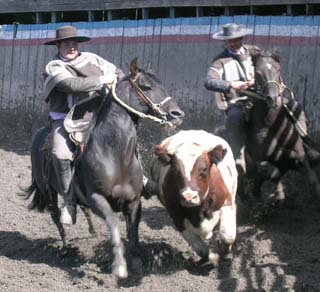
Two huasos (Chilean cowboys) on horseback have the difficult task of pinning down a frisky, young bull against the padded section of the arena boundary. Points are gained or lost depending on how elegantly it’s done and which part of the steer is sandwiched between the horse and the fence. It appears that accessories are equally important for the show.


With volcanoes sprouting all over the place we decided we had better climb one of them. Puyehue, standing at 2240m, was a grand choice. After a dip in the thermal pools of Aguas Calientes, we were ready to ascend this huge crater. From the summit the panoramic views were second to none and included at least 10 other volcanoes and numerous lakes.


We spent the night in a little hut on the tree line and then explored the vast volcanic moonscape NW of Puyehue. Undulating sandy terrain with pumice stones and black obsidian glass led to natural baños (hot springs) out in the wilds. Ahhh! Hot showers flowed from the rocks overhead and up into pools from underground springs. A garden of Eden in an otherwise deserted landscape.
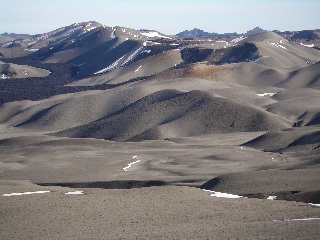
The predominant colour was grey, exploding into an array of yellows and reds around the fumaroles and lush green by the water sources. As evening approached and a sea of fog engulfed the valleys below, it gave yet another dimension to this impressive national park. Read more Chile below.



Our fourth
crossing of the Andes was the first that involved a pass above 1000m. It was quite painless and what’s more… paved! From volcano views in Chile, we crossed over to a completely different scenario of rust red mountains separated by a road and a gorge. Then it was picture postcard lake views all the way to Bariloche.
Bariloche is Argentina’s main mountain resort. With its tourist and chocolate industries, lakes, mountains and chalets, it resembles Switzerland quite a bit. It also happens to be a great place to hang out for a few days and… not bad for a shopping fix!
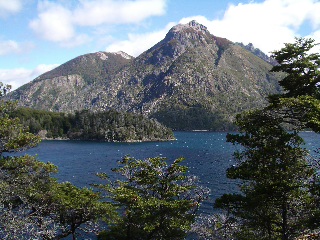
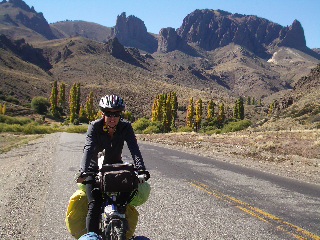
Leaving on Ruta 40, we cycled through Valle Encantado to Confluencia. A real enchanted valley with hilltop castlelike rock formations and protrusions.
As we turned off towards Paso del Cordoba, these formations became even more elaborate. Erosion at its creative best. Add the golds of autumn and you have a picture that highly compensates for the corrugated road below.

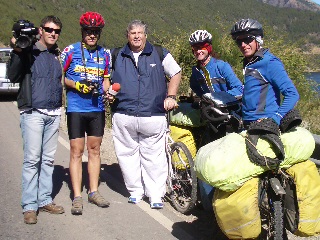
Just as we rolled into San Martín de los Andes, fame caught up with us again. This time in the extensive form of Nicanor, Argentina’s former rugby great. The microphone was shoved into our faces while the camera rolled and the whole trip was recounted in detail.
We must admit that the camera crew weren’t there for us alone, but also for the international duathlon scheduled for the following day! Where we stayed, we met a few of the athletes from Uruguay and Cordoba, and became their cheer leaders at the event.

Later we bumped into Urska and Marko, Slovenian cyclists who ascended from Ushuaia in half our time.

As we chatted over coffee, we discovered that Camino, our canine friend on the Carretera Austral, adopted them in Puerto Bertrand, where we parted company. Urska and Marko even cooked for Camino… but they called him Bert! So we reckon there’s an affectionate dog with a serious identity crisis on the loose in southern Chile.
Then it was time to cross the Andes again into Chile. The locals told us it would be easy to find…Just pass under the rainbow! And this time, they were spot on!
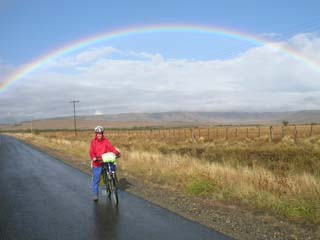
Our last night before the border crossing, we camped at the foot of Lanín volcano and had a very enjoyable evening round the campfire with Inez and Germán from Colombia.
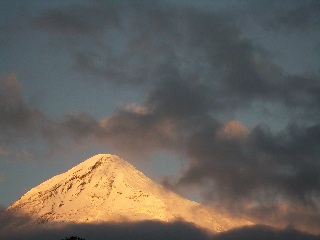
Our packs seemed mild in comparison with their expedition equipment of ice picks and crampons for their 6-month mountaineering adventure of South America. The next morning, Inez and Germán proceeded up the volcano while we cycled through araucaria forests into Chile and down to Pucón.
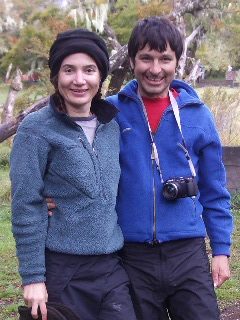
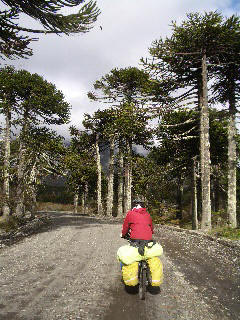

From Pucón we saw yet another perfect snow-capped cone. This time, Villarrica volcano. Being active, it puffs smoke all day and glows red through the night. A truly magnificent view that we could even admire from our bedroom windows in both Pucón and Villarrica.


We finally got to pick up our letters and Christmas cards in Villarrica… something like gold dust after nine months on the road. Thanks a million for all your news and good wishes.
On reaching Temuco, we topped our first 10,000km on this trip… and treated ourselves to a Chinese dinner and an overnight train to Santiago. This saved us about five days on the motorway and was well worth the few thousand pesos.
Barbara and Germán, Darina’s friends from Barcelona days, were the perfect hosts in Santiago and Viña del Mar. Both their families, including 3 great-grandparents, were very welcoming and showed us true Chilean hospitality.

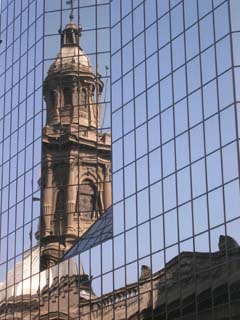
Santiago itself was a pleasant surprise. Cycling through this city of 6 million, it is possible to avoid most of the traffic by zig-zagging in and out of its numerous parks and bike lanes. Downtown is modern, well kept and dynamic with a hint of the past.
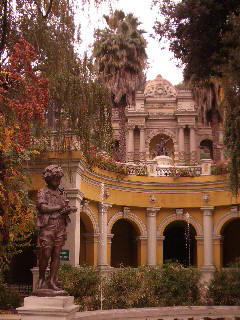


San Cristobal hill affords wonderful views of this caldron, enclosed by the cordillera costal range and the main Andes chain. Unfortunately, it’s not open for ventilation and a lid of smog completes the picture.
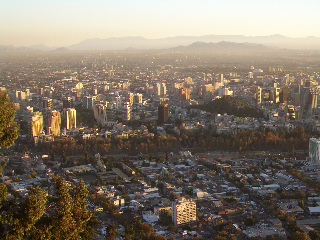
Barbara and Germán invited us down to Viña del Mar for the weekend, where we had a grand stroll along the beach before they sacrificed the whole day Sunday on a quest to find Darina’s Uncle John’s parish and church.

A mission impossible with the scant directions at our disposal. However, we did see barrios (suburbs) and cerros (hills) of both Viña and Valparaiso well off the beaten track. After another intensive search the following day, we finally found Las Palmas, where John’s parishioners were happy to show us around in his absence.
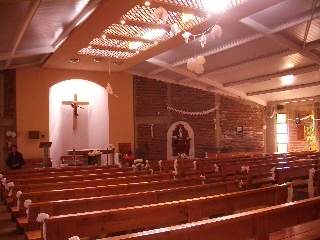
Valparaiso, a world heritage site, built on 45 or so hills was once South America’s most important port. Today, after a long decline, as a result of the opening of the Panama Canal, Valparaíso is back and booming like never before. But, it’s Valparaíso’s setting and organic, urban growth in these numerous cerros, that make it truly a-maze-ing.


Colourful houses crouching above on the edge, are accessed by 100 year old ascensores (lifts), originally operating on a counter-weight system. Cobblestone streets are laid out in an ad hoc fashion, unlike the chessboard grid of most South American cities. One of the best experiences you can have here is to get lost. There’s always something worth discovering round the next corner in this pearl of the Pacific.

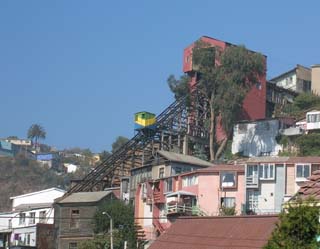
Ad hoc lay out of Valparaiso

A visit to this part of the world wouldn’t be complete without taking in one or two of Pablo Neruda’s houses. This poet, diplomat and political activist was a real child at heart. His whimsical homes reflect his jovial character and sense of fun and house his endless, fascinating collections of umbrellas, walking sticks, coloured glasses, insects, seashells, etc.

Now, it’s about time we crossed the Andes again – so stay tuned for the trials and tribulations of our next 10,000km!
